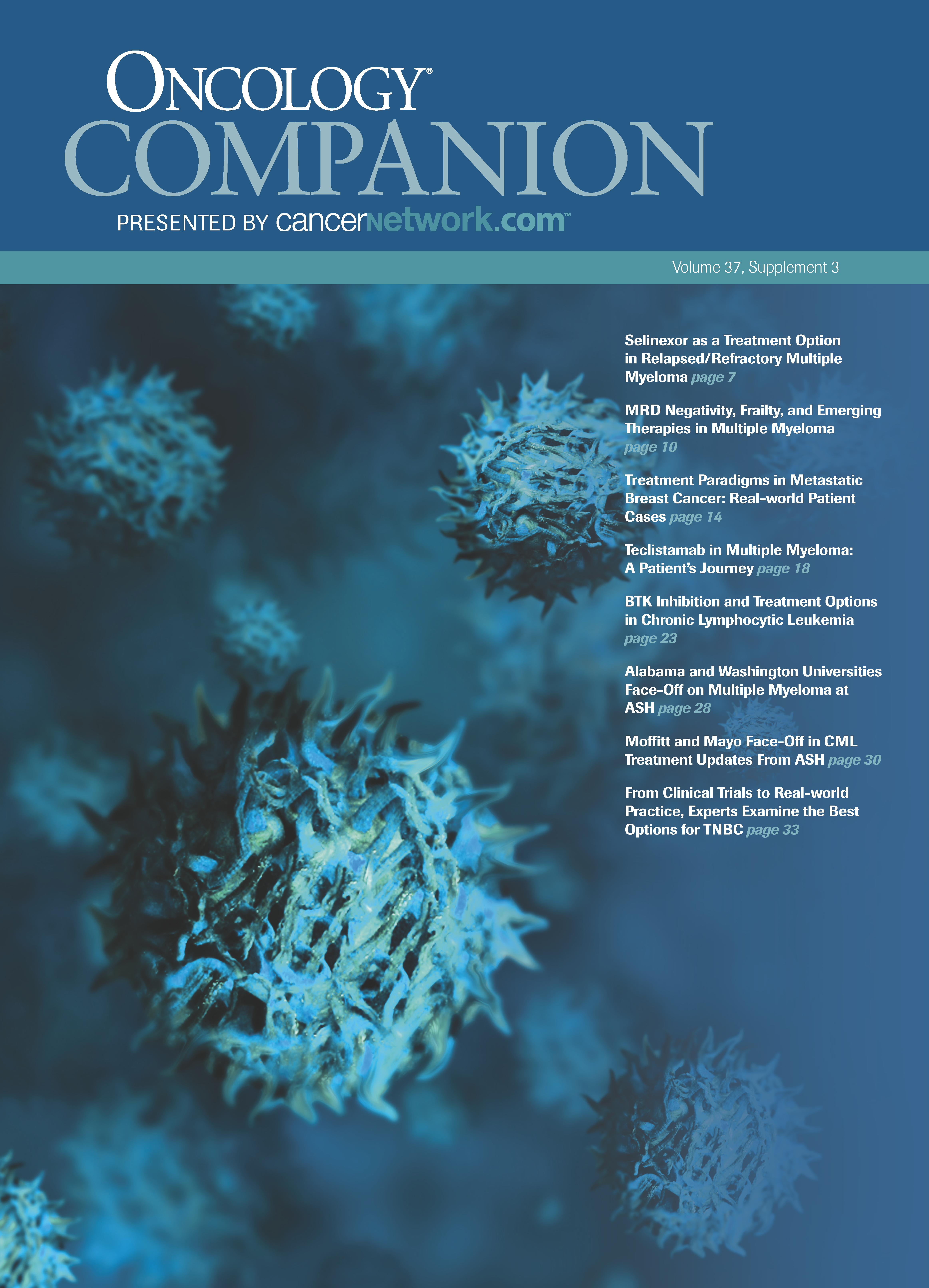Recap: Selinexor as a Treatment Option in Relapsed/Refractory Multiple Myeloma
Joshua Richter, MD, discusses the optimal use of selinexor in the treatment of relapsed/refractory multiple myeloma.

Precision medicine has been a hot topic in cancer care for years. As investigators find more ways to treat highly specific forms of cancer, matching the right patient with the right treatment has only become more important. Multiple myeloma is one area where this is especially true. In the frontline setting, regimens built on a foundation of bortezomib (Velcade), lenalidomide (Revlimid), and dexamethasone are saving lives, with more options and combinations being added to care providers’ toolboxes all the time. However, in the relapsed/refractory setting, treatment for multiple myeloma starts to look much different.
Selinexor (Xpovio), a selective inhibitor of nuclear export, is one promising treatment option for relapsed/refractory multiple myeloma. At a recent CancerNetwork® event, Joshua Richter, MD, an associate professor of medicine at The Tisch Cancer Institute and director of multiple myeloma at the Blavatnik Family-Chelsea Medical Center at Mount Sinai in New York, New York, sat down to speak about the use of selinexor in relapsed/refractory multiple myeloma, discussing both the experimental drug and today’s landscape for the treatment of multiple myeloma.
“When we think about patients with myeloma, we group them into 2 categories: newly diagnosed multiple myeloma and relapsed/refractory multiple myeloma,” Richter said. “Once patients go beyond their frontline, they enter into the realm of relapsed/refractory multiple myeloma, and we seek a variety of different options.”
Early in the relapsed/refractory setting, oncologists generally use immunomodulatory drugs (IMIDs) such as lenalidomide and pomalidomide (Pomalyst), according to Richter. Other common classes of drugs used in this setting include proteasome inhibitors, specifically bortezomib and carfilzomib (Kyprolis), as well as CD38 antibodies such as isatuximab-irfc (Sarclisa) and daratumumab (Darzalex). Beyond these are medications that use other mechanisms of action, he explained. These include selective inhibitors of nuclear export, like selinexor, and B-cell maturation antigen (BCMA)-targeted treatments, including chimeric antigen receptor (CAR) T-cell therapy and bispecific antibodies.
Matching Patients With Therapies
Richter explained that care providers consider 3 main types of factors when deciding on which treatment to give a specific patient: patient-related factors, disease-related factors, and treatment-related factors. The oncologist will then consider various questions within these main categories. When it comes to patient-related factors, the main questions are the patient’s age, possible medical frailties, and any comorbidities that may be present.
“We look at disease-related factors,” he said. “How aggressive is the disease? Is it relapsing quickly or slowly? Is there extramedullary disease? Is there central nervous system involvement? Are there high-risk cytogenetics?”
Treatment-related considerations include which kind of drugs a patient has already received, which ones the patient does not respond to, which ones prompt a positive response, and whether a patient has ongoing toxicities from a particular treatment. “For example, if we think about a patient [who] receives an [IMID], like lenalidomide, and progresses rather quickly, my next line of therapy is not likely going to rely solely on pomalidomide [or] another drug within that class,” Richter said. Instead, he said he would seek to switch to another class of drugs in hopes of getting a better response.
Triple-, Quad-, and Penta- Refractory Multiple Myeloma
Even considering FDA approvals of multiple myeloma therapies, some patients’ disease responds poorly to various types of treatment, Richter said. When a patient fails to respond to 1 drug in each of the 3 main classes—that is, has myeloma that does not respond to an IMID, a proteasome inhibitor, or a CD38 antibody— they are classified as having triple-class refractory disease.
Some patients may have cancer that resists treatment even with more than 1 drug from each of these 3 main classes. For example, if a patient does not respond to IMIDs, proteasome inhibitors, and a CD38 antibody, they are considered quad-refractory, according to Richter. A patient whose disease is refractory to lenalidomide, pomalidomide, bortezomib, carfilzomib, and daratumumab are classified as penta-refractory.
Prognosis in these patients is very poor, Richter said. Pointing to data from the 2019 retrospective MAMMOTH study, he noted that although most patients who are newly diagnosed can expect to live for a decade or longer with their disease, this survival drops precipitously among patients whose disease is refractory to multiple lines of therapy.1 For example, the MAMMOTH study found that those who were triple refractory had an overall survival (OS) of less than 1 year, whereas those who were penta-refractory had a median OS of just 5.6 months. “Once you’re refractory to a drug within each class, or certainly refractory to all 5, you need to look to novel mechanisms of action to get better outcomes and better survival,” Richter said.
Selinexor in Multiple Myeloma
As a selective inhibitor of nuclear export, selinexor uses a different mechanism of action from those found in other types of therapy. Specifically, selinexor stops cancer cells from bypassing their programmed death mechanism, Richter said.
“Essentially, when the body produces a cancer cell and recognizes that it’s cancer, it targets it for a programmed cell death, [or] apoptosis,” he said. “Cellularly, there’s a cascade of events that happen. Let’s call that 1 through 6, where the cell gets signaled and inside the nucleus, [the cell goes through steps] 1, 2, 3, 4, 5, and 6, then the cell commits suicide and dies. Well, one of the ways cancer cells like to survive is to take part of that equation and kick it outside the nucleus.”
Cancer cells jettison the signals necessary to complete cell death, thus allowing the cancer to survive and proliferate, Richter explained. The cell kicks out these signals by ejecting them from the nucleus via perforations called expectorants, or XP01. For instance, if the cell receives instructions for the first 2 stages of apoptosis but exports the third step from the nucleus, the cancer will not only survive but also spread. “Selinexor selectively inhibits nuclear export,” Richter said. “It blocks XP01 and traps the cell from trying to kick those elements outside the nucleus, therefore forcing the cell to undergo cell death and [leading] to a better control of malignancies.”
Selinexor is the first drug to use this mechanism of action. One major plus to selinexor treatment is that the drug can be combined with a variety of other medications, opening patients with refractory disease to new options, Richter said. “Once you have a new mechanism of action in a disease like myeloma, you don’t just get one more therapeutic option, you get a multitude of options,” he said.
Combining Selinexor With Other Therapies
The phase 1/2 STOMP study (NCT02343042) investigated IMIDs such as pomalidomide and lenalidomide, CD38 antibodies such as daratumumab, and proteasome inhibitors such as bortezomib and carfilzomib. Investigators said they found that selinexor combined with bortezomib and dexamethasone produced significant anticancer activity in patients with refractory myeloma, with an acceptable safety profile.2
Furthermore, Richter said that research presented at the 64th American Society of Hematology (ASH) Annual Meeting and Exposition indicated that a combination of selinexor, carfilzomib, and dexamethasone showed promise for patients living with triple-refractory disease.3 Although the study had a very small sample size of just 33 patients receiving the study therapy, investigators reported that the selinexor triplet combination yielded an overall response rate of 66.7% (95% CI, 34.9%-90.1%). The median progression-free survival was reported at 13.8 months (95% CI, 5.3–not estimable [NE]), and the median duration of response was reported at 1 year (95% CI, 12-NE). The reported median OS was approximately 33 months (95% CI, 20.4-NE).
“We’re looking at patients who’ve now been exposed to and refractory to multiple classes of agents, and they were able to have a significant number of them respond and have durable responses, as well,” Richter said.
Furthermore, the data showed that these therapies were tolerable, although cytopenias remained a major concern in the context of treating any hematologic malignancy, he explained. “Overall, the major worries we see with things such as cardiac events were extremely minimal in this study. So overall, what this study brings about is that for patients in the third or fourth line plus, those who are carfilzomib naïve, this represents an excellent treatment option for them,” he said.
Selinexor is also a good option for patients who were initially eligible for belantamab mafodotin-blmf (Blenrep) before it was pulled from approval, Richter said. As other therapies develop, new combinations of drugs offer intriguing possibilities. “One of the things that were very prominent at the 2022 ASH meeting were some updates regarding the bispecific antibodies in multiple myeloma, and there [are several] them in clinical trials,” Richter said.
Teclistamab-cqyv (Tecvayli) has already been approved by the FDA, based on results from the phase 2 MajesTEC trial (NCT03145181; NCT04557098), and elranatamab may soon follow.4 Furthermore, these drugs, which Richter said demonstrated response rates of between approximately 60% and 80%, seem to produce even better response rates in combination with other therapies. In one example, teclistamab is being studied in combination with daratumumab in patients with multiple myeloma, he said.
“Again, these are posting very high response rates, and a lot of these studies are also being informed by some of our prior umbrella or combination studies, such as STOMP, where we combined selinexor with drugs like daratumumab, pomalidomide, or lenalidomide,” Richter said. “Ultimately, what these combination studies show, both with selinexor and with the bispecifics, is that as patients take their individual journey throughout myeloma, we’ll have an answer for everyone.”
Triplet therapy appears to work better than doublet therapy in multiple myeloma, according to Richter. Although clinicians may be hesitant to place frailer patients on triplet therapy, Richter said he would pursue a dose-adjusted triplet therapy rather than a full-dose doublet course to maximize the number of mechanisms fighting cancer.
Unmet Needs in Multiple Myeloma
In one major case of unmet need, patients who are very heavily refractory to therapy have very few options, Richter said. These include patients who are not only penta-refractory but who are also refractory to BCMA inhibitors. “What happens when patients progress beyond CAR T?” he said. “We don’t have answers.”
Other underserved populations include the elderly, who underperform with multiple myeloma treatment, he said. Furthermore, racial disparities persist, with patients of African, African American, Asian, and Latino descent lagging behind White patients in how they fare on treatment.
More specifically, Richter said, is the question of how to treat patients in the third- or fourth-line setting. “A lot of our great therapies are for patients with 4 lines [or more] of therapy, so at the moment, CAR T-cell therapy and bispecific antibodies are for patients who have had at least 4 lines of prior therapy, and we’re having difficulty [with] what to do in that fourth line,” he said.
References
- Gandhi UH, Cornell RF, Lakshman A, et al. Outcomes of patients with multiple myeloma refractory to CD38-targeted monoclonal antibody therapy. Leukemia. 2019;33(9):2266-2275. doi:10.1038/s41375-019-0435-7
- Richter J, Madduri D, Richard S, Chari A. Selinexor in relapsed/refractory multiple myeloma. Ther Adv Hematol. 2020;11:2040620720930629. doi:10.1177/2040620720930629
- Schiller GJ, Tuchman SA, Callander N, et al. Once weekly selinexor, carfilzomib and dexamethasone (XKd) in triple class refractory multiple myeloma. Blood. 2022;140(suppl 1):10050-10053. doi:10.1182/blood-2022-158011
- FDA approves teclistamab-cqyv for relapsed or refractory multiple myeloma. News release. FDA. October 25, 2022. Accessed February 14, 2023. https://bit.ly/3I2wN2z
EP: 1.Overview of Multiple Myeloma and Treatment Options
EP: 2.Role of Selinexor in Patients with Relapsed/Refractory Multiple Myeloma
EP: 3.Selinexor, Carfilzomib and Dexamethasone (XKd) in Triple-Class Refractory MM
EP: 4.Bispecific Antibodies in the Treatment of Multiple Myeloma
EP: 5.Clinical Pearls and Unmet Needs in R/R Multiple Myeloma
EP: 6.Recap: Selinexor as a Treatment Option in Relapsed/Refractory Multiple Myeloma

Navigating AE Management for Cellular Therapy Across Hematologic Cancers
A panel of clinical pharmacists discussed strategies for mitigating toxicities across different multiple myeloma, lymphoma, and leukemia populations.